A
MEMORY OF NEW STREET
Winter 1942/43
|
There is already a small queue at the
bus shelter in New Street. My mother and I join the end
of it. People hurry by us in both directions, their clothing
mainly dark and devoid of colour, their faces pale. The
majority are women, carrying shopping bags or tugging
children; almost all wear a felt hat of some sort with
just the odd one bare-headed or in a head-scarf tied in
the form of a turban. Hats, overcoats, gloves, scarves,
nothing of what they wear is fresh or new. Just down the
street a newspaper seller is offering the two local evening
papers, the Despatch and the Mail, with the familiar cry: "Spatchermile.........
spatchermile". Above all of our heads in the cold,
winter sky the first few starlings are returning to their
homes on roofs and ledges after a day of foraging in parks
and suburban gardens. Soon there will be thousands of
them, wheeling overhead in great dark clouds, their chirping
a continuous chorus almost drowning out the noise of the
traffic. How strange is their desire to rush into the
city centre at this time of the day when I and everyone
else are happy to be leaving it.
Earlier we have been in
Lewis's, a regular
destination for our visits to Birmingham in my school
holidays. Afterwards I walk down
Corporation Street holding
my mother's hand. We make a quick visit into
Midland Educational
for some minor item connected with my schooling. As usual
the contents of the shop do not register much with me
- after all, it is not a proper toyshop - and in any case
I possess in my mind no standard by which to measure the
inadequacy of the wartime stock. Then it is into
Pattison's
where my mother is due to meet an old office friend of
hers, Mrs. Hewitt, an
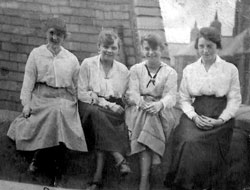 older lady with whom she had worked
at the Law Courts at the other end of Corporation Street
in 1918 when an earlier war had been raging. There they
had both typed for an up-and-coming young Birmingham barrister,
Norman Birkett, later
Baron Birkett of Ulverston, of whom great things had been expected
which would later be achieved in full as he eventually
attained high office in the Judiciary.
older lady with whom she had worked
at the Law Courts at the other end of Corporation Street
in 1918 when an earlier war had been raging. There they
had both typed for an up-and-coming young Birmingham barrister,
Norman Birkett, later
Baron Birkett of Ulverston, of whom great things had been expected
which would later be achieved in full as he eventually
attained high office in the Judiciary.
(Here is my mother at
around that time -
second from right - on the roof of the Law Courts
with three of her colleagues).
The three of us
are seated at a small round table in the cafe, the ladies
nattering. I sit transfixed with boredom, trying not to
look at a brimming ashtray in the middle of the table,
its pile of butt ends still showing traces of the lipstick
or saliva of total strangers and being added to every
ten minutes or so by my mother and her friend. It is an
image and a feeling of disgust which I shall retain all
my life and will ensure that whatever I die of, it will
not be smoking-related. I munch my slice of sponge cake,
a dry affair with a smear of red, fruitless jam inside
it - the finding of any trace of a genuine strawberry
on such occasions would be a miracle - and sip my cup
of tea. The cup is cracked, like many others. My mother
notices it. "Drink from near the handle, dear, and
avoid the crack", she whispers to me. It's a familiar
refrain.
After saying our goodbyes, accompanied
on my part by the obligatory raising of school cap, we
walk on down Corporation Street. Beyond the junction with
New Street and further in the distance we can see the
smoke-blackened, Victorian edifice of
New Street Station, its entrance
as usual bustling with activity. Where the two streets
intersect we cross diagonally in two stages using the
central reservation. This pedestrian refuge prevents the
two opposing streams of one-way New Street traffic from
colliding and feeds them from each direction either into
Stephenson Place towards the station or up along Corporation
Street. We turn left and slowly walk the few yards down
New Street in the general direction of the
Bull Ring to
reach our bus shelter and join our fellow passengers,
all of us waiting for the No. 113 Midland Red. There is
no need to hurry.
Eventually - but not for at least another
quarter of an hour - our bus, always a double-decker,
will appear and I can anticipate that moment. It
will emerge from High Street to our right
in front of a tall, modern building bearing the name
"The
Times Furnishing Co"; its white façade appears
undamaged in contrast to the wrecked buildings beside
it. (I can never understand why a Birmingham shop should
bear the name of a newspaper - it is just one of life's
many mysteries). Then it will pull up in front of us having
reached its terminus and stand there, rattling in time
with the throb of its engine and emitting a smell of scorched
brake or clutch lining.
At this stage of the day few people will alight, perhaps a
soldier or airman or sailor stepping confidently off the
back of the platform in the direction of travel before the
bus comes to a stop and then hoisting kit bag onto
shoulder and striding purposefully off in the direction of
New Street Station or
Snow Hill.
When
all its homeward bound passengers have boarded, I know
that the bus
will set off, moving diagonally to the right across
New
Street, as it always does,
before rounding the corner and roaring off up
Corporation Street past the shops we have recently
visited, then turning left into
Bull Street and pulling
up outside Grey's department store. Here another group
of home-going passengers will step off the pavement and
clamber aboard. Then off again, turning right in front
of Snow Hill Station into
Steelhouse Lane and, once past
the General Hospital, left into
Loveday Street. We shall
now have moved away from the central area of the city
but the buildings will still be tall, towering over the
bus. Every so often there are gaps where the Luftwaffe
has done its work. These bomb sites will sometimes have
been cleared but more often still contain a great pile
of rubble covered by dull, winter vegetation and the
remains of last autumn's willow herb. Usually they are
bounded by a sheer, blank wall, that of an adjoining
building which has somehow survived, and sometimes shorn
up by vast timbers. Such walls fascinate me. They are
often studded throughout their height by rows of little
fireplaces, the colour of the tiles still bright and a
small rectangle of the surrounding wall bearing the
flowered wallpaper of a living room or bedroom. I find
difficulty in reconciling these sights with my own
experience. Fireplaces should be on the ground floor, in
a lounge or dining room, or perhaps one storey up, in a
bedroom. But not stretching up three or four floors,
almost up to the sky. And who used to sit around them
and where are they now?
As the bus passes through
Aston along
Summer Lane I know that the buildings will become smaller, side-street
after side-street of back-to-back terraced houses, sometimes
with a gaping hole in their midst or a row of homes damaged
and boarded up. Past the Crocodile Works where, despite what my elder sister tells me with a straight face on another occasion, I am well aware that they make something other than large predatory reptiles. Then onward through
Perry Barr with its cinema
and shops and the junction where the Outer Circle buses
cross our path; and onward towards
New Oscott and
College
Arms where our route turns left on to the
Chester Road.
After Beggar's Bush there is the feeling that we have
finally left the city behind as
Sutton Park spreads out
to our right. Onward past Banner's Gate and the
Parson
& Clerk. There is much evidence of 1930s building
along the road here in Streetly, abruptly brought to a
halt in 1939; I shall later learn that this is called
"ribbon development". But it is by no means
continuous and from the top of the bus I shall be able
to look out, here and there, over great swathes of open
countryside. At each stop we disgorge another small group
of passengers. The last of them leaves at the
Hardwick
Arms crossroads where the bus will turn and park on the
main road near to Cutler's Garage,
ready for its return to the city. But that is all to come.......
We are still here, in the bustle
of New Street. I anticipate the journey, undertaken
so many times before. But it is not
our turn yet. My mother and I stand there, waiting for
the 4.15 to arrive, and look out across the street. It is a
year or two after the bombing of 1940 and 1941. As far
as I am concerned the street has always looked like this
and probably always will. The buildings behind me seem
to have emerged unscathed. The Odeon cinema, a few paces
down the street, appears to be open, as is a crowded little
snack bar near to where we are standing. Of course it
is difficult to tell what the state of the upper storeys
is and, anyway, that is all part of normal life and not
really of any interest to me at all.
On the other side of the street, though,
it is a different story. Directly opposite is
Horne's,
a gentlemen's outfitters housed in an ornate Victorian
brick building similar to many further up
New Street towards
the Town Hall. It is open for business. But I think that
it is only part of the ground floor which is available
to the owners. Above, the windows seem to be missing or
blanked out; behind them one assumes is chaos, scorched
debris, fallen timbers, missing roof. I can see some lights
on already somewhere within, in the area which is open
to customers. The official blackout time is still an hour
or two away after which not the faintest glimmer will
be visible; but I shall be safely back home by then.
To the left of Horne's is a building which
always fascinates me. It is, or rather was, a tall, light-coloured,
confident modern building, but it is now grubby and forlorn.
My mother tells me that it used to be
Marshall and Snelgrove's,
a beautiful shop which she visited from time to time and
I try to imagine it in its original state, its white façade
pristine and crowds of customers going in and out of its
doors.
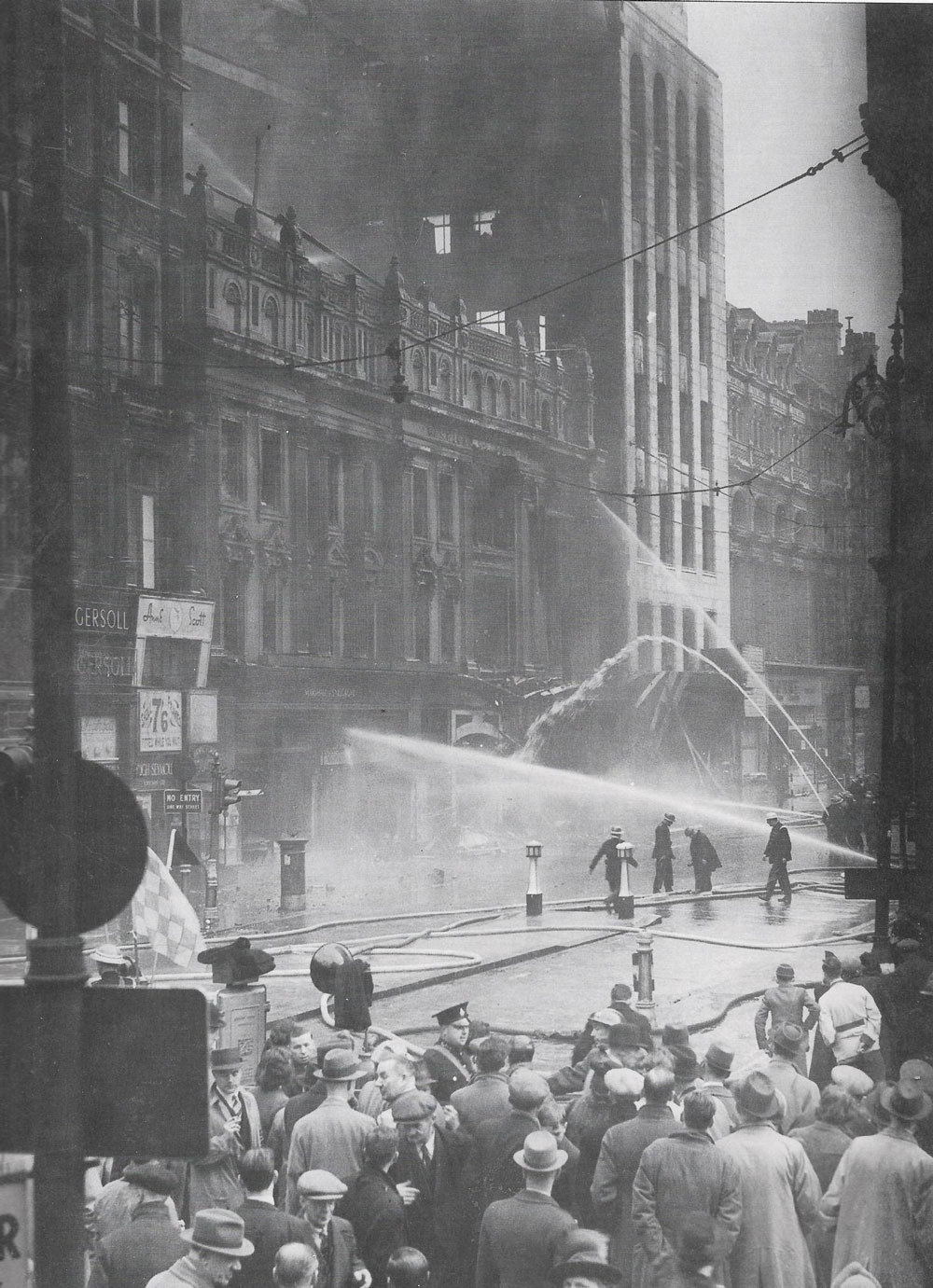 I must have seen it then but was too young for
the image to have registered. Today it is just a shell,
still standing, but above each of its many curved windows,
now blank and gaping, a great black smear stretches up
the stonework where flames and smoke erupted from within
as the interior was being consumed. This image
(left)
shows a fire being dealt with, next door, during the
morning of 25th September 1940. Perhaps the shop was
damaged at that time; but it was a month later, in
October, when the building was wholly burnt out, to create
the appearance which I am now seeing. It is hard to
imagine
how it can ever be restored to its former glory but it
will be, eventually, in the form of a replacement with
a broader façade and in a rough approximation of
the original form and texture.
I must have seen it then but was too young for
the image to have registered. Today it is just a shell,
still standing, but above each of its many curved windows,
now blank and gaping, a great black smear stretches up
the stonework where flames and smoke erupted from within
as the interior was being consumed. This image
(left)
shows a fire being dealt with, next door, during the
morning of 25th September 1940. Perhaps the shop was
damaged at that time; but it was a month later, in
October, when the building was wholly burnt out, to create
the appearance which I am now seeing. It is hard to
imagine
how it can ever be restored to its former glory but it
will be, eventually, in the form of a replacement with
a broader façade and in a rough approximation of
the original form and texture.
The traffic between me and these buildings
is light. It is passing from right to left. Much of it is buses, the red
Midland and the
dark-blue and yellow Birmingham Corporation on which I
very rarely travel. Almost all are double-deckers, seating
over 50 people and carrying many more standing but only
on the lower deck. It is mainly the Midland Red that I
notice, the ones I am most familiar with. Most originate
from pre-war; they are solid, substantial vehicles retaining
their padded, cloth upholstery, with registration prefixes
of HA or AHA. But increasingly they are being supplemented
by the newer "utility" buses, gaunt, angular,
spindly vehicles with hard suspension and slatted wooden
seats. From time to time a single-decker will pass, of
pre-war vintage and occasionally very antique, even to
my eyes, dating back to the very early 1930s. There are
a few cars, almost all of them black in colour, and often
a railway mechanical horse, a strange, articulated vehicle
consisting of a flat platform or a boxed-in van structure,
hauled by a three-wheeled "horse".
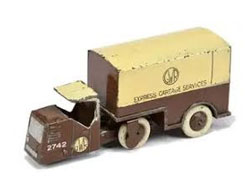 (My favourite
Dinky Toy is a pre-war representation of one of these
vehicles
(right) in the chocolate and cream livery of the
Great
Western Railway Company; one day in the future it will
disappear, perhaps liberated by a playmate who finds it
attractions irresistible). Occasionally a car will pass
with a huge, wallowing rubber bag lashed to its roof,
overhanging both bonnet and boot and filled with town
gas to fuel its progress in these days of tight petrol
rationing. All of these vehicles will have fitted over
their headlamps the familiar, round, black, metal masks
bearing rows of hooded, horizontal slits through which
glimmers of light will emerge to help the vehicle feel its
way after dark. The edges of mudwings and other extremities
on all the public vehicles and many of the private ones
are painted white to give pedestrians and other road users
a chance of seeing the vehicle looming out of the darkness.
(My favourite
Dinky Toy is a pre-war representation of one of these
vehicles
(right) in the chocolate and cream livery of the
Great
Western Railway Company; one day in the future it will
disappear, perhaps liberated by a playmate who finds it
attractions irresistible). Occasionally a car will pass
with a huge, wallowing rubber bag lashed to its roof,
overhanging both bonnet and boot and filled with town
gas to fuel its progress in these days of tight petrol
rationing. All of these vehicles will have fitted over
their headlamps the familiar, round, black, metal masks
bearing rows of hooded, horizontal slits through which
glimmers of light will emerge to help the vehicle feel its
way after dark. The edges of mudwings and other extremities
on all the public vehicles and many of the private ones
are painted white to give pedestrians and other road users
a chance of seeing the vehicle looming out of the darkness.
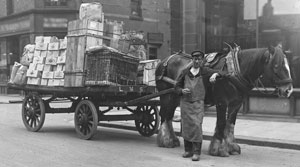 There are still horse-drawn vehicles about,
usually brewers' drays bearing the name of their owners,
Ansells or
Mitchell & Butlers, or carts belonging
to the LMS or
GWR. One of these vehicles draws up alongside
the pavement to my right, as they sometimes do. The driver
in muffler and cloth cap gets down off his cart, comes
to the head of the horse and ties on its nosebag. As he
completes this operation the horse starts to eat and simultaneously
decides to empty its bladder, to my delight. What amazes
me is the volume that the animal produces. It spreads
out for several feet around over the surface of the street,
and lingers there on the cobbles, steaming in the cold
air. The driver pays not the slightest attention and moves
down the flank to adjust the harness in some way. In fascination
I watch his small, hob-nailed boots splash through the
pool with a muffled clatter. He doesn't even glance down.
And here's me, I ponder, who gets ticked off for even
thinking of walking through a puddle of rainwater.
There are still horse-drawn vehicles about,
usually brewers' drays bearing the name of their owners,
Ansells or
Mitchell & Butlers, or carts belonging
to the LMS or
GWR. One of these vehicles draws up alongside
the pavement to my right, as they sometimes do. The driver
in muffler and cloth cap gets down off his cart, comes
to the head of the horse and ties on its nosebag. As he
completes this operation the horse starts to eat and simultaneously
decides to empty its bladder, to my delight. What amazes
me is the volume that the animal produces. It spreads
out for several feet around over the surface of the street,
and lingers there on the cobbles, steaming in the cold
air. The driver pays not the slightest attention and moves
down the flank to adjust the harness in some way. In fascination
I watch his small, hob-nailed boots splash through the
pool with a muffled clatter. He doesn't even glance down.
And here's me, I ponder, who gets ticked off for even
thinking of walking through a puddle of rainwater.
Buses arrive although still not yet ours.
The bus-stops along this part of
New Street serve mainly
the routes out of Birmingham to the north of the city,
all Midland Red.
The 118 goes to Walsall and there is a series of numbers
denoting routes via the middle of
Sutton Coldfield. The
101 goes to Streetly, as ours does, but travels via Sutton
and terminates in Streetly village; the 102 to
Mere Green,
the 103 to Canwell. The 104, a more infrequent service,
is always operated by a single-decker and pursues a circuitous
route from New Street through Sutton and Streetly before
disappearing off down the Chester Road towards
Brownhills
and finally ending up somewhere over the horizon in a
distant place called Cannock. Another service which picks
up here in New Street is one which is always identified
by the conductor bellowing "Beeches" as he is
doing today, meaning, as I find out much later, the
Perry
Beeches Estate at Great Barr.
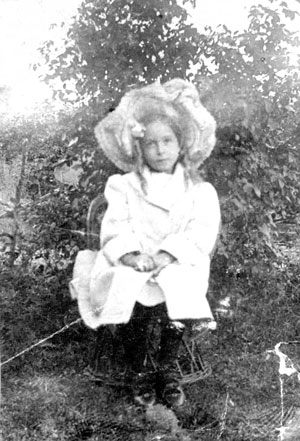 As our queue lengthens a flower seller
approaches us. She is offering small bunches of lavender.
She has a dreadful deformity in one of her arms which
appals me and I try not to look at it. She is either ignored
or dismissed with a slight shake of the head by our fellow
passengers. She accepts these rejections resignedly and
approaches us. My mother
(right, in 1906/7) is a gentle soul who once told
me about a lavender seller of her Edwardian childhood
who had a pitch in
Station Street, the sight being so
pathetic that it used to make her cry and beg her grandmother
to hand over a few coppers. In character, she uses a few kindly and gentle words
as she declines the offer. She is
rewarded by a torrent of abuse before the seller moves
on to the next group of potential customers.
As our queue lengthens a flower seller
approaches us. She is offering small bunches of lavender.
She has a dreadful deformity in one of her arms which
appals me and I try not to look at it. She is either ignored
or dismissed with a slight shake of the head by our fellow
passengers. She accepts these rejections resignedly and
approaches us. My mother
(right, in 1906/7) is a gentle soul who once told
me about a lavender seller of her Edwardian childhood
who had a pitch in
Station Street, the sight being so
pathetic that it used to make her cry and beg her grandmother
to hand over a few coppers. In character, she uses a few kindly and gentle words
as she declines the offer. She is
rewarded by a torrent of abuse before the seller moves
on to the next group of potential customers.
As my mother recovers from the hurt my
eye moves back to the other side of the street. To the
right of Horne's there is nothing. A vast expanse of flat
ground, not a trace of the Victorian and Edwardian buildings
which once towered there. Nothing. The rubble which spilled
out over New Street the morning after the bombing has
all gone and with it every vestige of this part of the
earlier Birmingham. One can see right across to
High Street
where the row of buses probably includes our own. The
flat area acquires the name of
Big Top when a vast marquee
is erected on it for the purpose of circus or other entertainment.
I shall be there in a few weeks, as a birthday treat,
to see the circus. We will go on a day of strong wind
and be surrounded by the noise of slapping canvas and
creaking structure as we laugh at the clowns and watch
the parading horses. It will be a relief to my mother
to emerge unscathed. A day or so later, after a further
increase in the strength of the winds, we will read in
the Evening Mail that the tent has blown down.
But that is in the future and back here
in the present our bus has arrived. We shuffle on board
and at my insistence climb the stairs to the top deck
which is less crowded and where the view is far better.
The fug of cigarette smoke starts to grow as more passengers
light up but that is just about tolerable, as is the thought
which always lurks in the back of the mind: whether the
driver of this unwieldy and top-heavy vehicle will exercise
due caution when negotiating the tighter bends on the
journey. The conductor squeezes down the central aisle
in order to collect our fares, holding a clipboard containing
a row of different coloured paper tickets, starting with
a white one for a fare of one penny. My mother offers
the correct fare and two tickets are extracted, punched
in a little machine which dangles around the conductor's
neck and handed over. Then she - for more often than not
these days the conductors are, more accurately, conductresses
- moves on down the aisle to the next passenger.
I sit there and gaze out of the window
at a Birmingham whole areas of which will disappear within
a couple of decades, a concept quite beyond my wildest
dreams or comprehension. My thoughts are shorter term,
just as far ahead as this coming evening. Tonight is
ITMA
and Tommy Handley on the wireless. I shall listen and laugh, and later
will probably lie on the soft hearth rug in front of the
open fire while the faithful wireless continues to mutter
in the background, bringing the latest news from
Russia
or North Africa or the
Far East,
or of last night's bombing raid on the
Ruhr. I shall stretch
out there on my front, chin resting on my hands, and gaze
deep into the glowing coals. There I shall see frightening
caverns and passageways opening up, with flames of red
and orange and purple within, spitting and sizzling, flaring
and fading; for me they will be images of a burning city.
And then I shall try to imagine what peace will be like,
if it ever comes. But that is an unnatural state and one
I never succeed in visualising, this or any other evening.......
**********
ACKNOWLEDGEMENTS AND OTHER
COMMENT
All of the
above recollections are as honest and accurate as the
author can make them, subject to distortions of the
memory over many decades. But any correction, and in
particular comment on any anachronism which might have crept in, will be welcomed.
Please use the website
Feedback
function on the Home Page; or post in the thread in the
Local History group/Forum if that has been your route to
this page.
Grateful
acknowledgement is made to the unknown original owners
of the several street scenes above and of the Dinky Toy
image.
All other images
are from the Myers Family Archive.
Unless otherwise
stated all images and text are
© staffshomeguard
2007-2024